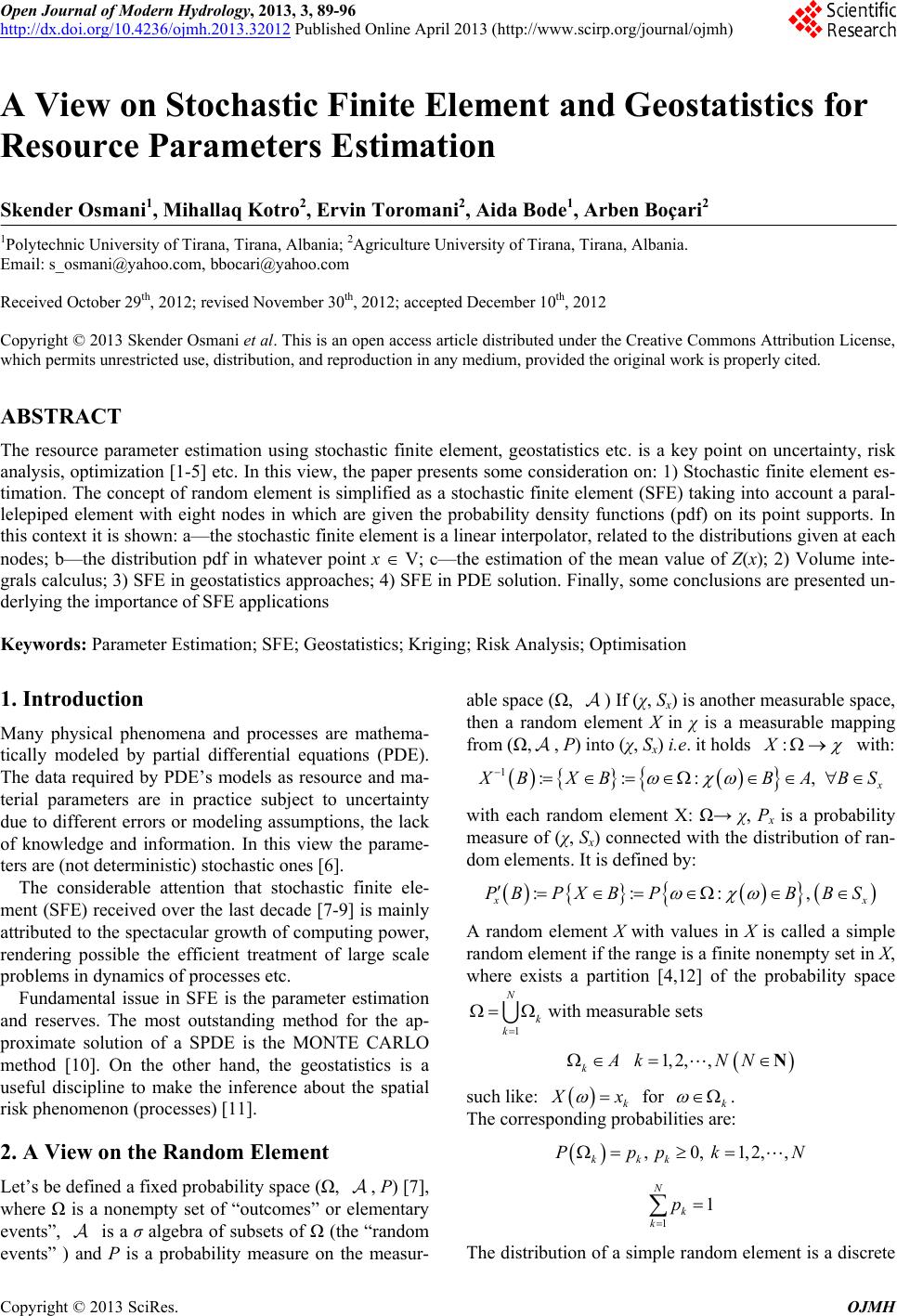 Open Journal of Modern Hydrology, 2013, 3, 89-96 http://dx.doi.org/10.4236/ojmh.2013.32012 Published Online April 2013 (http://www.scirp.org/journal/ojmh) 89 A View on Stochastic Finite Element and Geostatistics for Resource Parameters Estimation Skender Osmani1, Mihallaq Kotro2, Ervin Toroman i2, Aida Bode1, Arben Boçari2 1Polytechnic University of Tirana, Tirana, Albania; 2Agriculture University of Tirana, Tirana, Albania. Email: s_osmani@yahoo.com, bbocari@yahoo.com Received October 29th, 2012; revised November 30th, 2012; accepted December 10th, 2012 Copyright © 2013 Skender Osmani et al. This is an open access article distributed under the Creative Commons Attribution License, which permits unrestricted use, distribution, and reproduction in any medium, provided the original work is properly cited. ABSTRACT The resource parameter estimation using stochastic finite element, geostatistics etc. is a key point on uncertainty, risk analysis, optimization [1-5] etc. In this view, the paper presents some consideration on: 1) Stochastic finite element es- timation. The concept of random element is simplified as a stochastic finite element (SFE) taking into account a paral- lelepiped element with eight nodes in which are given the probability density functions (pdf) on its point supports. In this context it is shown: a—the stochastic finite element is a linear interpolator, related to the distributions given at each nodes; b—the distribution pdf in whatever point x V; c—the estimation of the mean value of Z(x); 2) Volume inte- grals calculus; 3) SFE in geostatistics approaches; 4) SFE in PDE solution. Finally, some conclusions are presented un- derlying the importance of SFE applications Keywords: Parameter Estimation; SFE; Geostatistics; Kriging; Risk Analysis; Optimisation 1. Introduction Many physical phenomena and processes are mathema- tically modeled by partial differential equations (PDE). The data required by PDE’s models as resource and ma- terial parameters are in practice subject to uncertainty due to different errors or modeling assumptions, the lack of knowledge and information. In this view the parame- ters are (not deterministic) stochastic ones [6]. The considerable attention that stochastic finite ele- ment (SFE) received over the last decade [7-9] is mainly attributed to the spectacular growth of computing power, rendering possible the efficient treatment of large scale problems in dynamics of processes etc. Fundamental issue in SFE is the parameter estimation and reserves. The most outstanding method for the ap- proximate solution of a SPDE is the MONTE CARLO method [10]. On the other hand, the geostatistics is a useful discipline to make the inference about the spatial risk phenomenon (processes) [11]. 2. A View on the Random Element Let’s be defined a fixed probability space (Ω, , P) [7], where Ω is a nonempty set of “outcomes” or elementary events”, is a σ algebra of subsets of Ω (the “random events” ) and P is a probability measure on the measur- able space (Ω, ) If (χ, Sx) is another measurable space, then a random element X in χ is a measurable mapping from (Ω,, P) into (χ, Sx) i.e. it holds :X with: 1::: , BXB BS BA with each random element X: Ω→ χ, Px is a probability measure of (χ, Sx) connected with the distribution of ran- dom elements. It is defined by: :::, x PBB PS P k X B B A random element X with values in X is called a simple random element if the range is a finite nonempty set in X, where exists a partition [4,12] of the probability space 1 N k with measurable sets N1, 2,,Ak NN k such like: k x for k . The corresponding probabilities are: , 0, 1, kkk Pppk 2,, N 1 1 N k k p The distribution of a simple random element is a discrete Copyright © 2013 SciRes. OJMH 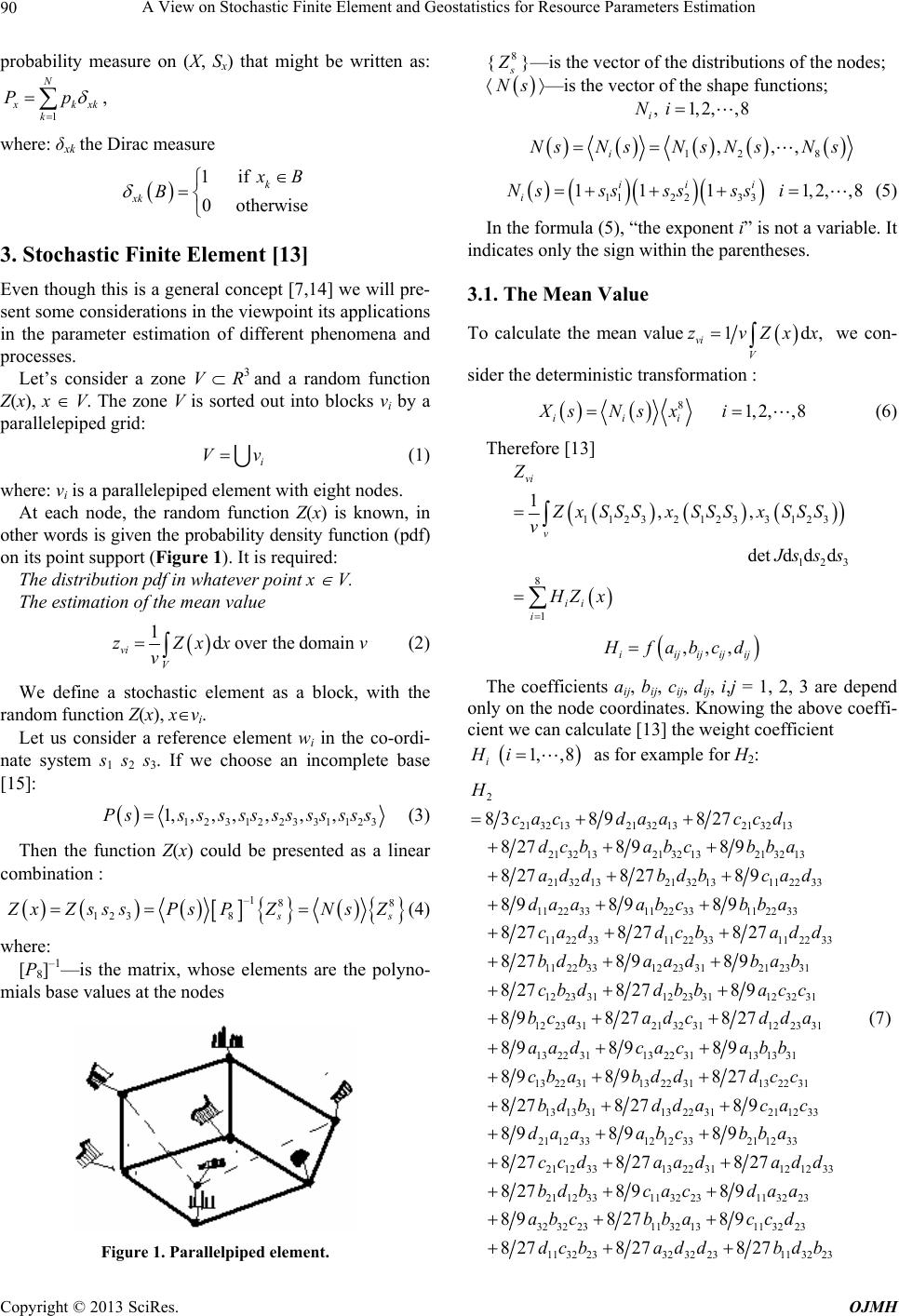 A View on Stochastic Finite Element and Geostatistics for Resource Parameters Estimation 90 probability measure on (X, Sx) that might be written as: 1 N kxk k Pp , where: δxk the Dirac measure 1if 0otherwis k xk e B B 3. Stochastic Finite Element [13] Even though this is a general concept [7,14] we will pre- sent some considerations in the viewpoint its applications in the parameter estimation of different phenomena and processes. Let’s consider a zone V R3 and a random function Z(x), x V. The zone V is sorted out into blocks vi by a parallelepiped grid: i Vv (1) where: vi is a parallelepiped element with eight nodes. At each node, the random function Z(x) is known, in other words is given the probability density function (pdf) on its point support (Figure 1). It is required: The distribution pdf in whatever point x V. The estimation of the mean value 1doverthe domain vi V zZxx v v (2) We define a stochastic element as a block, with the random function Z(x), xvi. Let us consider a reference element wi in the co-ordi- nate system s1 s2 s3. If we choose an incomplete base [15]: 123122331123 1, ,,,,,,Ps ssssssssssss (3) Then the function Z(x) could be presented as a linear combination : –1 88 123 8 s xZsssPsPZNsZ (4) where: [P8]–1—is the matrix, whose elements are the polyno- mials base values at the nodes Figure 1. Parallelpiped element. {8 }—is the vector of the distributions of the nodes; Ns—is the vector of the shape functions; , 1,2,,8 i Ni 12 8 ,,, i NsN sN sNsNs 11223 3 11 11,2, iii i Nsssssssi ,8 (5) In the formula (5), “the exponent i” is not a variable. It indicates only the sign within the parentheses. 3.1. The Mean Value To calculate the mean value 1 vi V zvZxd,x we con- sider the deterministic transformation : 8 1,2,,8 iii XsNs xi (6) Therefore [13] 1 12321233 123 12 3 8 1 1,, detd dd vi v ii i Z ZxSS SxSS SxSS S v sss HZx ,,, iijijijij fabcd The coefficients aij, bij, cij, dij, i,j = 1, 2, 3 are depend only on the node coordinates. Knowing the above coeffi- cient we can calculate [13] the weight coefficient 1,,8 i Hi as for example for H2: 2 21 321321 32 13213213 21 32 132132 1321 3213 21 32 1321 3213112233 11223311 223311 2233 1122 331122331122 33 11 22 83 89827 82789 89 827827 89 8989 89 827827 827 827 H cac daaccd dcb abcbba addbdb cad daaabc bba ca ddc badd bd b 331223312123 31 12 233112 23 3112 32 31 12 23312132 31122331 89 89 827 827 89 89 827827(7) aad bab cbddbb acc bc aadcdda 13 2231132231131331 13 223113223113 22 31 1313 311322312112 33 2112331212332112 33 2112 331322 311212 33 2112 33 8989 89 89 89827 827 82789 8989 89 827 827827 827 aadcac abb cbabd ddcc bdbdd acac d aaabcbba ccdaad add bdb 11 32 2311 3223 32322311 321311 3223 1132 233232231132 23 89 89 89827 89 827 827827 cac daa abcbba ccd dcba d dbdb Copyright © 2013 SciRes. OJMH 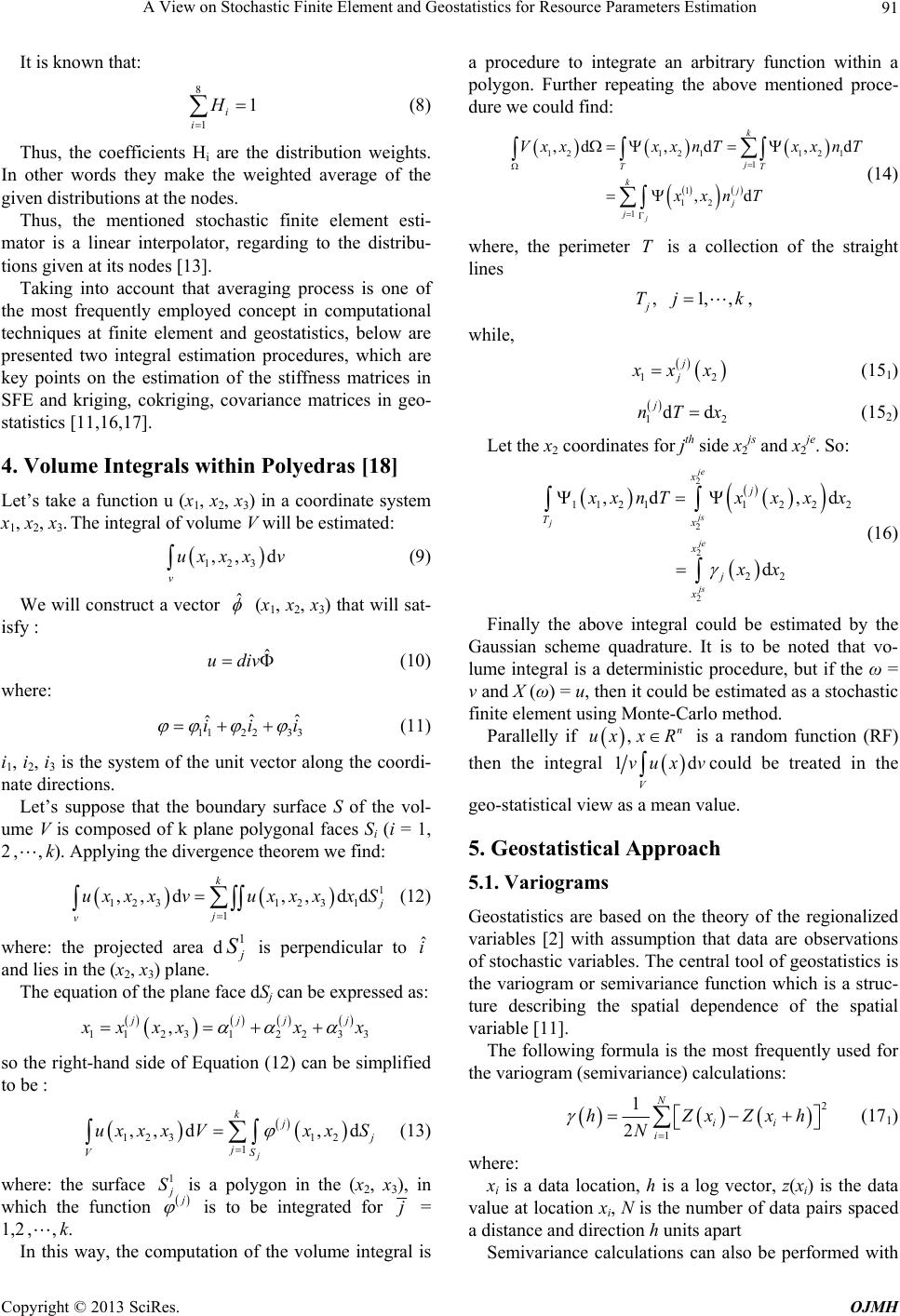 A View on Stochastic Finite Element and Geostatistics for Resource Parameters Estimation 91 It is known that: 8 1 1 i i H (8) Thus, the coefficients Hi are the distribution weights. In other words they make the weighted average of the given distributions at the nodes. Thus, the mentioned stochastic finite element esti- mator is a linear interpolator, regarding to the distribu- tions given at its nodes [13]. Taking into account that averaging process is one of the most frequently employed concept in computational techniques at finite element and geostatistics, below are presented two integral estimation procedures, which are key points on the estimation of the stiffness matrices in SFE and kriging, cokriging, covariance matrices in geo- statistics [11,16,17]. 4. Volume Integrals within Polyedras [18] Let’s take a function u (x1, x2, x3) in a coordinate system x1, x2, x3. The integral of volume V will be estimated: 123 ,, d v ux xxv (9) We will construct a vector ˆ (x1, x2, x3) that will sat- isfy : ˆ udiv (10) where: 112 233 ˆˆˆ iii (11) i1, i2, i3 is the system of the unit vector along the coordi- nate directions. Let’s suppose that the boundary surface S of the vol- ume V is composed of k plane polygonal faces Si (i = 1, 2k). Applying the divergence theorem we find: ,, 1 123123 1 1 ,, d,, dd k j v uxxxvuxxx xS (12) where: the projected area d is perpendicular to and lies in the (x2, x3) plane. 1 j Sˆ i The equation of the plane face dSj can be expressed as: 11231223 , jjj 3 j xxxx x so the right-hand side of Equation (12) can be simplified to be : 123 12 1 ,, d,d j kj j VS ux xxVx xS (13) where: the surface 1 S is a polygon in the (x2, x3), in which the function is to be integrated for j = 1,2 ,k. , In this way, the computation of the volume integral is a procedure to integrate an arbitrary function within a polygon. Further repeating the above mentioned proce- dure we could find: 1212 112 1 1 1 12 1 ,d,d,d ,d j k j TT kj j j VxxxxnT xxnT xxn T (14) where, the perimeter T is a collection of the straight lines , 1,, j Tjk 2 , while, 1 j j xx (15 1) 1 dd j nT x2 (15 2) Let the x2 coordinates for jth side x2 js and x2 je. So: 2 2 2 2 112112 22 22 ,d ,d d je js j je js x j Tx x j x xnTxxxx xx (16) Finally the above integral could be estimated by the Gaussian scheme quadrature. It is to be noted that vo- lume integral is a deterministic procedure, but if the ω = v and X (ω) = u, then it could be estimated as a stochastic finite element using Monte-Carlo method. Parallelly if ,n ux x R is a random function (RF) then the integral 1vuxd V v could be treated in the geo-statistical view as a mean value. 5. Geostatistical Approach 5.1. Variograms Geostatistics are based on the theory of the regionalized variables [2] with assumption that data are observations of stochastic variables. The central tool of geostatistics is the variogram or semivariance function which is a struc- ture describing the spatial dependence of the spatial variable [11]. The following formula is the most frequently used for the variogram (semivariance) calculations: 2 1 1 2 N ii i hZxZx N h (17 1) where: xi is a data location, h is a log vector, z(xi) is the data value at location xi, N is the number of data pairs spaced a distance and direction h units apart Semivariance calculations can also be performed with Copyright © 2013 SciRes. OJMH  A View on Stochastic Finite Element and Geostatistics for Resource Parameters Estimation 92 data from RS images for example as a cross variogram. It is defined as half of the average product of the log dis- tance relative to the two variables Z and Y. 1 1 2 zy nh ii ii i h xZx hYxYx h N (172 ) where: Z (x1) and Y (x1) are the data value in point x1 for two bands (profiles); N is the number of data separated by length of the vector h; A variogram usually is characterized by three para- meters [2]: Sill—the platean that the semivariogram reaches; Range—the distance at which two data points are uncorrelated; Nugget—the vertical discontinuity at the origin. Usually the application of the semivariograms requires that the data accomplish the intrinsic hypothesis for a regionalized variable. In other words a random function Z(x) is said to be intrinsic when: the mathematical expectation exists and does not depend on the support x EZxm x (18) for all vectors h the incerement Z(x + h) – Z(x) has a fi- nite variance which does not depend on x 2 ––VarZxh ZxEZxhZxx (19) where: Z(x) is a random function i.e. locally at a point x1, Z(x1) is a random variable and Z(x1) and Z(x1 + h) are generally independent but are related by a correlation expressing the spatial structure of the initial regionalized variable Z(x). Experimental variogrames are approximated by dif- ferent models like: spherical, exponential, Gaussian, cir- cular, tetraspherical, pentaspherical, Hole effect, K— Bessel etc. [2,16,18]. 5.2. Kriging in SFE View [13] Let be Z(x) the random function and the estimation of the mean value: 1d V V Zx x v (20) over a given domain v is required knowing a support of discrete values ,1,, n . According to the Kriging approach 2 the linear esti- mator k of the n data values is considered: 1 1d n k v ZZZx v The n weights are calculated under the classic hypothesis of the moments: EZx m 2 2 –o –2 EZx hZxmCh EZx hZxh r (22) We must be assure that the estimator is unbiased as well as the variance is minimal. Let us suppose that one (or both) of two hypotheses are not accomplished and both the expectation of Z(x) and the covariance depend on x: EZx mx ,CxhEZx hZxmxhmx (23) Before taking into consideration this hypothesis, it should be underlined, whatever the moment functions are going to be, they should always lead to a positive vari- ance. Also, we will show the calculation of Kriging solu- tion using SFE but without considering its existence and uniqueness (It is not the aim of this paper). To ensure that estimator is unbiased we impose the condition: 1 0 n v mm (24) With 1d v V mEZvx EZxx v , 1d1, V mEZv EZxxn v , (25) The estimation variance is: 22–2 vkvvk k EZ ZEZEZZEZ (26) Taking into account the expression of 2 v EZ we have: 2 2 88 , 11 1dd v ijv iyi ii EZExZxZyy v cEZ xZy (27) Also 88 , 11 88 , 11 , , ijviyi ii ijijvi vj ii v cEZxZy cCvvmm Cvv (28) x (21) where: Copyright © 2013 SciRes. OJMH 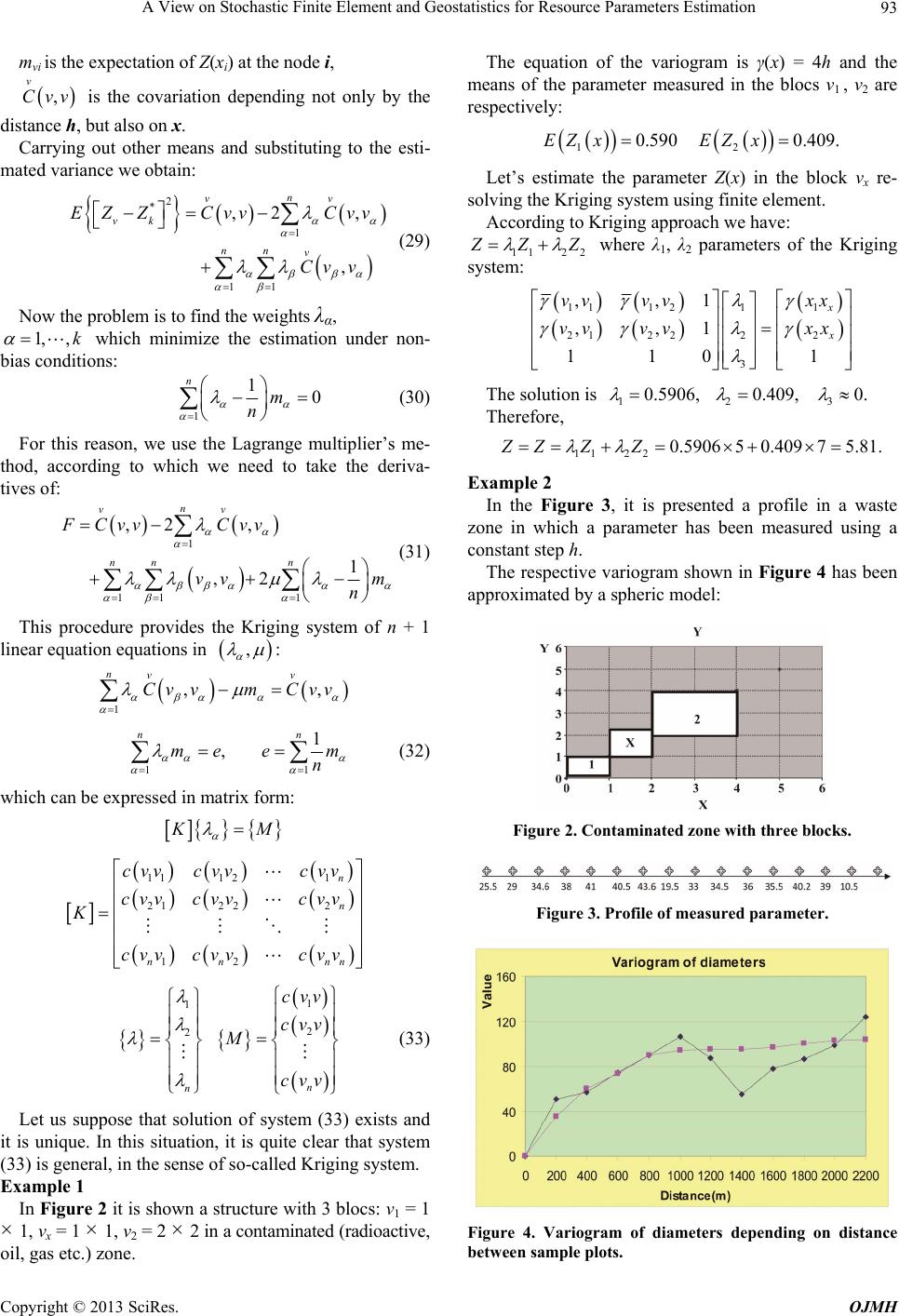 A View on Stochastic Finite Element and Geostatistics for Resource Parameters Estimation 93 mvi is the expectation of Z(xi) at the node i, , v Cvv is the covariation depending not only by the distance h, but also on x. Carrying out other means and substituting to the esti- mated variance we obtain: 2 * 1 11 ,2 , , n vv vk nnv EZ ZCvvCvv Cv v (29) Now the problem is to find the weights λα, 1,, k which minimize the estimation under non- bias conditions: 1 10 n m n (30) For this reason, we use the Lagrange multiplier’s me- thod, according to which we need to take the deriva- tives of: 1 11 1 ,2 , 1 ,2 n vv nn n FCvv Cvv vv m n (31) This procedure provides the Kriging system of n + 1 linear equation equations in , : 1 ,, nvv Cv vmCvv 11 1 , nn me em n (32) which can be expressed in matrix form: M 11 121 21 222 12 n n nn n cvv cvvcvv cvv cvvcvv K cvv cvvcvv n 1 2 n (33) 1 2 n cvv cvv M cvv Let us suppose that solution of system (33) exists and it is unique. In this situation, it is quite clear that system (33) is general, in the sense of so-called Kriging system. Example 1 In Figure 2 it is shown a structure with 3 blocs: v1 = 1 × 1, vx = 1 × 1, v2 = 2 × 2 in a contaminated (radioactive, oil, gas etc.) zone. The equation of the variogram is γ(x) = 4h and the means of the parameter measured in the blocs v1 , v2 are respectively: 12 0.590 0.409.EZ xEZx Let’s estimate the parameter Z(x) in the block vx re- solving the Kriging system using finite element. According to Kriging approach we have: 112 2 ZZ where λ1, λ2 parameters of the Kriging system: 11 1211 212 222 3 ,,1 ,,1 110 1 x x vv vvxx vv vvxx The solution is 10.5906, 20.409, 3 0. Therefore, 112 20.5906 50.409 75.81.ZZ ZZ Example 2 In the Figure 3, it is presented a profile in a waste zone in which a parameter has been measured using a constant step h. The respective variogram shown in Figure 4 has been approximated by a spheric model: Figure 2. Contaminated zone with three blocks. Figure 3. Profile of measured parameter. Figure 4. Variogram of diameters depending on distance between sample plots. Copyright © 2013 SciRes. OJMH 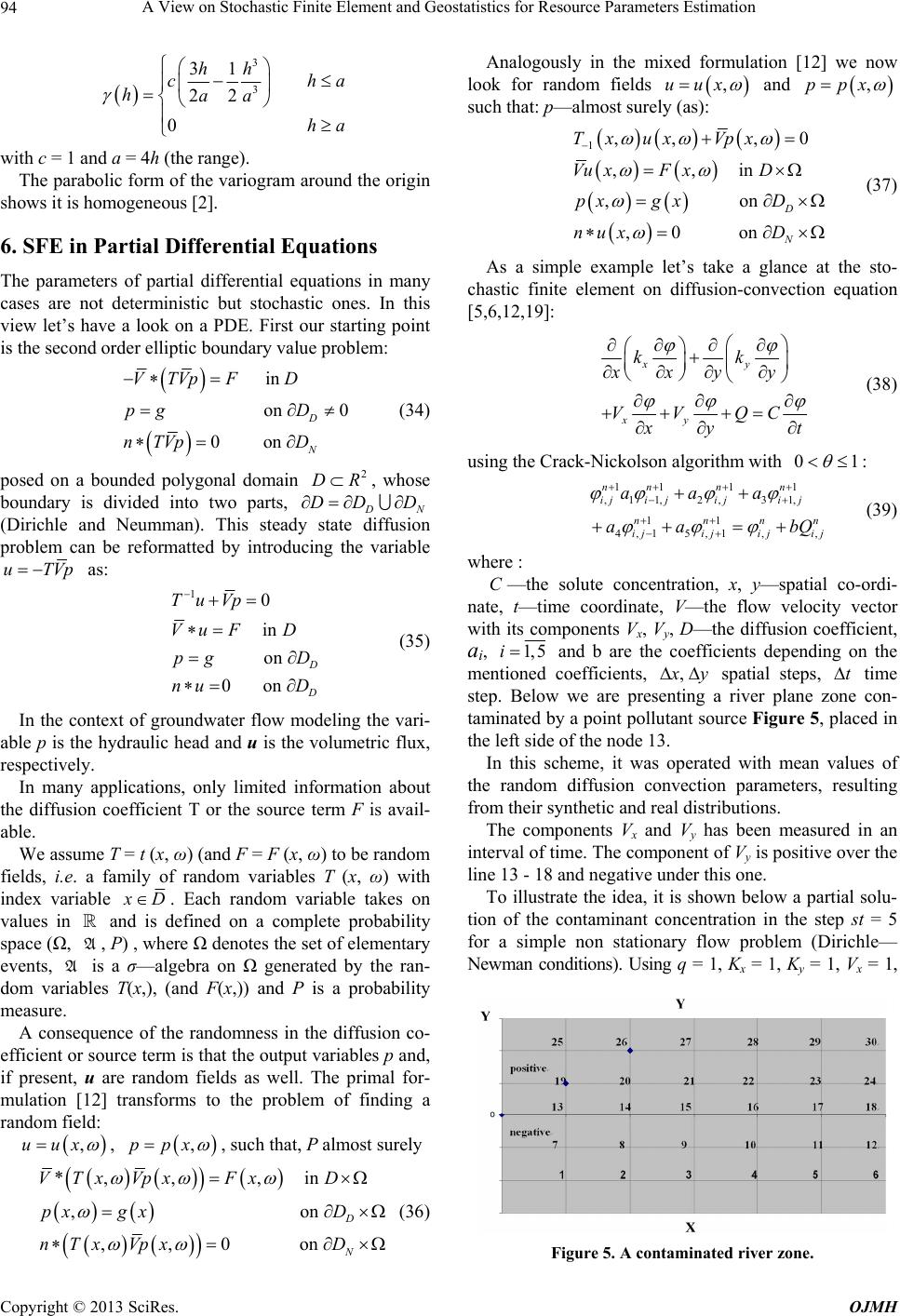 A View on Stochastic Finite Element and Geostatistics for Resource Parameters Estimation 94 3 3 31 22 0 hh ch haa ha a with c = 1 and a = 4h (the range). The parabolic form of the variogram around the origin shows it is homogeneous [2]. 6. SFE in Partial Differential Equations The parameters of partial differential equations in many cases are not deterministic but stochastic ones. In this view let’s have a look on a PDE. First our starting point is the second order elliptic boundary value problem: in on 0 0on D N VTVp FD pg D nTVp D (34) posed on a bounded polygonal domain , whose boundary is divided into two parts, 2 DR N (Dirichle and Neumman). This steady state diffusion problem can be reformatted by introducing the variable DDD uTVp as: 10 in on 0on TuVp Vu FD pg D nu D (35) In the context of groundwater flow modeling the vari- able p is the hydraulic head and u is the volumetric flux, respectively. In many applications, only limited information about the diffusion coefficient T or the source term F is avail- able. We assume T = t (x, ω) (and F = F (x, ω) to be random fields, i.e. a family of random variables T (x, ω) with index variable D. Each random variable takes on values in and is defined on a complete probability space (Ω, , P) , where Ω denotes the set of elementary events, is a σ—algebra on Ω generated by the ran- dom variables T(x,), (and F(x,)) and P is a probability measure. A A A consequence of the randomness in the diffusion co- efficient or source term is that the output variables p and, if present, u are random fields as well. The primal for- mulation [12] transforms to the problem of finding a random field: ,uux , ,ppx , such that, P almost surely *,,, in ,o ,,0 on D N VTx VpxFxD px gxD nTx VpxD n (36) Analogously in the mixed formulation [12] we now look for random fields ,uux and ,ppx such that: p—almost surely (as): 1,, ,0 ,,in ,on ,0 on D N Tx uxVpx Vu xFxD px gxD nux D (37) As a simple example let’s take a glance at the sto- chastic finite element on diffusion-convection equation [5,6,12,19]: xy xy kk xxyy VVQC yt (38) using the Crack-Nickolson algorithm with 01 : 111 1 ,11, 2,31, 11 4,15,1,, nnn n iji jiji j nnn ijijij ij aaa aa bQ n (39) where : C—the solute concentration, x, y—spatial co-ordi- nate, t—time coordinate, V—the flow velocity vector with its components Vx, Vy, D—the diffusion coefficient, ai, 1, 5i and b are the coefficients depending on the mentioned coefficients, , y spatial steps, t time step. Below we are presenting a river plane zone con- taminated by a point pollutant source Figure 5, placed in the left side of the node 13. In this scheme, it was operated with mean values of the random diffusion convection parameters, resulting from their synthetic and real distributions. The components Vx and Vy has been measured in an interval of time. The component of Vy is positive over the line 13 - 18 and negative under this one. To illustrate the idea, it is shown below a partial solu- tion of the contaminant concentration in the step st = 5 for a simple non stationary flow problem (Dirichle— Newman conditions). Using q = 1, Kx = 1, Ky = 1, Vx = 1, Figure 5. A contaminated river zone. Copyright © 2013 SciRes. OJMH 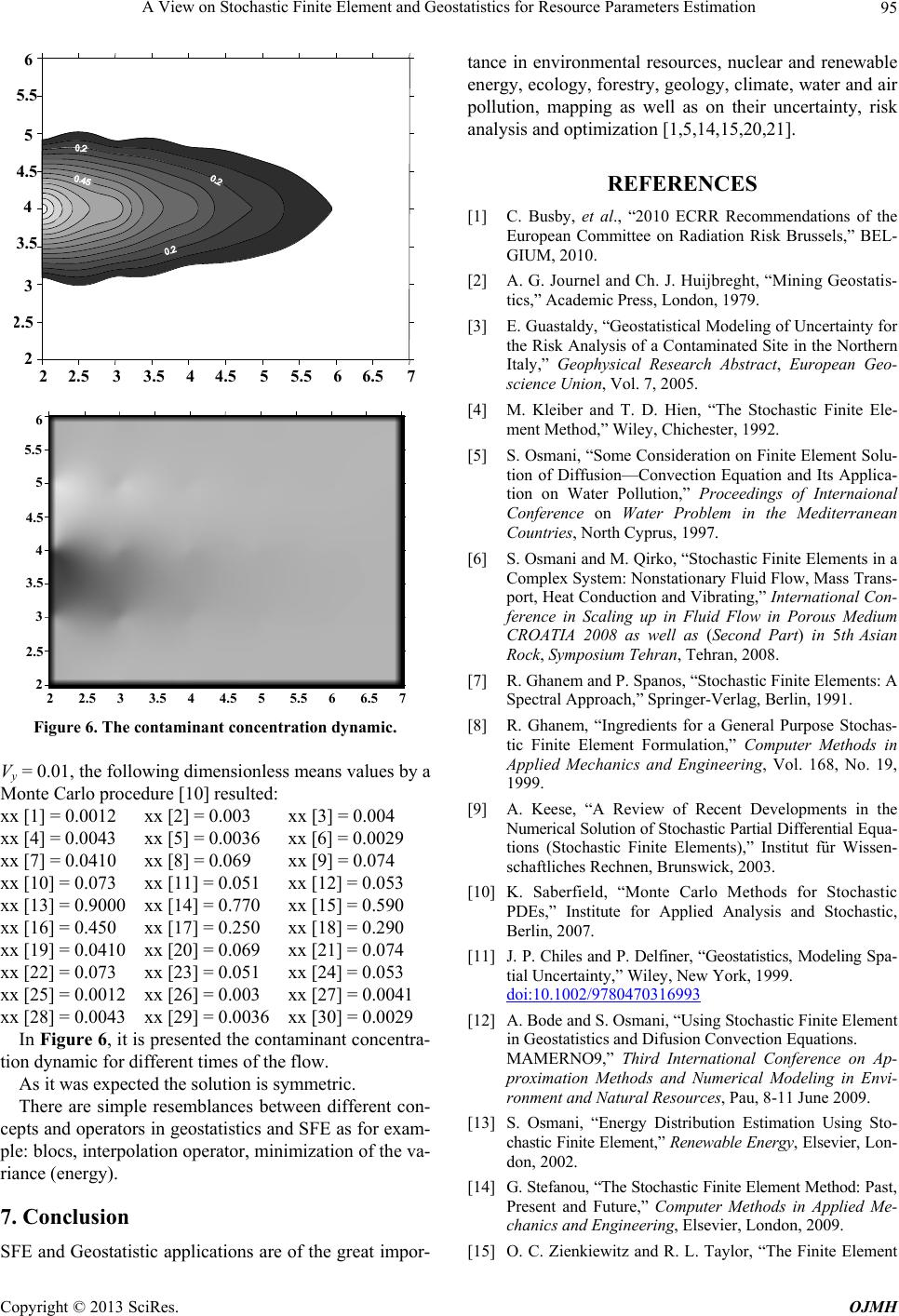 A View on Stochastic Finite Element and Geostatistics for Resource Parameters Estimation 95 2 2.533.54 4.555.56 6.57 2 .5 3 3.5 4 4.5 5 5.5 6 22.533.544.555.566.57 2 2.5 3 3.5 4 4.5 5 5.5 6 Figure 6. The contaminant concentration dynamic. Vy = 0.01, the following dimensionless means values by a Monte Carlo procedure [10] resulted: xx [1] = 0.0012 xx [2] = 0.003 xx [3] = 0.004 xx [4] = 0.0043 xx [5] = 0.0036 xx [6] = 0.0029 xx [7] = 0.0410 xx [8] = 0.069 xx [9] = 0.074 xx [10] = 0.073 xx [11] = 0.051 xx [12] = 0.053 xx [13] = 0.9000 xx [14] = 0.770 xx [15] = 0.590 xx [16] = 0.450 xx [17] = 0.250 xx [18] = 0.290 xx [19] = 0.0410 xx [20] = 0.069 xx [21] = 0.074 xx [22] = 0.073 xx [23] = 0.051 xx [24] = 0.053 xx [25] = 0.0012 xx [26] = 0.003 xx [27] = 0.0041 xx [28] = 0.0043 xx [29] = 0.0036 xx [30] = 0.0029 In Figure 6 , it is presented the contaminant concentra- tion dynamic for different times of the flow. As it was expected the solution is symmetric. There are simple resemblances between different con- cepts and operators in geostatistics and SFE as for exam- ple: blocs, interpolation operator, minimization of the va- riance (energy). 7. Conclusion SFE and Geostatistic applications are of the great impor- tance in environmental resources, nuclear and renewable energy, ecology, forestry, geology, climate, water and air pollution, mapping as well as on their uncertainty, risk analysis and optimization [1,5,14,15,20,21]. REFERENCES [1] C. Busby, et al., “2010 ECRR Recommendations of the European Committee on Radiation Risk Brussels,” BEL- GIUM, 2010. [2] A. G. Journel and Ch. J. Huijbreght, “Mining Geostatis- tics,” Academic Press, London, 1979. [3] E. Guastaldy, “Geostatistical Modeling of Uncertainty for the Risk Analysis of a Contaminated Site in the Northern Italy,” Geophysical Research Abstract, European Geo- science Union, Vol. 7, 2005. [4] M. Kleiber and T. D. Hien, “The Stochastic Finite Ele- ment Method,” Wiley, Chichester, 1992. [5] S. Osmani, “Some Consideration on Finite Element Solu- tion of Diffusion—Convection Equation and Its Applica- tion on Water Pollution,” Proceedings of Internaional Conference on Water Problem in the Mediterranean Countries, North Cyprus, 1997. [6] S. Osmani and M. Qirko, “Stochastic Finite Elements in a Complex System: Nonstationary Fluid Flow, Mass Trans- port, Heat Conduction and Vibrating,” International Con- ference in Scaling up in Fluid Flow in Porous Medium CROATIA 2008 as well as (Second Part) in 5th Asian Rock, Symposium Tehran, Tehran, 2008. [7] R. Ghanem and P. Spanos, “Stochastic Finite Elements: A Spectral Approach,” Springer-Verlag, Berlin, 1991. [8] R. Ghanem, “Ingredients for a General Purpose Stochas- tic Finite Element Formulation,” Computer Methods in Applied Mechanics and Engineering, Vol. 168, No. 19, 1999. [9] A. Keese, “A Review of Recent Developments in the Numerical Solution of Stochastic Partial Differential Equa- tions (Stochastic Finite Elements),” Institut für Wissen- schaftliches Rechnen, Brunswick, 2003. [10] K. Saberfield, “Monte Carlo Methods for Stochastic PDEs,” Institute for Applied Analysis and Stochastic, Berlin, 2007. [11] J. P. Chiles and P. Delfiner, “Geostatistics, Modeling Spa- tial Uncertainty,” Wiley, New York, 1999. doi:10.1002/9780470316993 [12] A. Bode and S. Osmani, “Using Stochastic Finite Element in Geostatistics and Difusion Convection Equations. MAMERNO9,” Third International Conference on Ap- proximation Methods and Numerical Modeling in Envi- ronment and Natural Resources, Pau, 8-11 June 2009. [13] S. Osmani, “Energy Distribution Estimation Using Sto- chastic Finite Element,” Renewable Energy, Elsevier, Lon- don, 2002. [14] G. Stefanou, “The Stochastic Finite Element Method: Past, Present and Future,” Computer Methods in Applied Me- chanics and Engineering, Elsevier, London, 2009. [15] O. C. Zienkiewitz and R. L. Taylor, “The Finite Element Copyright © 2013 SciRes. OJMH  A View on Stochastic Finite Element and Geostatistics for Resource Parameters Estimation Copyright © 2013 SciRes. OJMH 96 Method,” 5th Edition, The Basic, Elsevier, Oxford, 2000. [16] P. Govartes, “Geostatistics for Natural Resources Evalua- tion,” Oxford University, New York, 1997. [17] S. Osmani, “Finite Element on Geostatistique Calcula- tions,” In: A. G. Fabri et Royer, Ed., 3rd International Codata Conference in Geomathematics and Geostatistics Science de la Terre, Nancy, 1994. [18] G. Dasgupta, “Integration within Polygonal Finite Ele- ments,” Journal of Aerospace Engineering, Vol. 16, No. 1, 2003, pp. 9-18. doi:10.1061/(ASCE)0893-1321(2003)16:1(9) [19] S. Osmani, “Finite Element Method (in Albanian),” Tirana, 2009. [20] Nuclear Energy, “The Future Climat,” The Royal Society, Portsmuth, 1999. [21] S. Osmani, “A Model of Convection Diffusion Equation in 3D with Finite Elements,” 17th International Biennal Conference Numerical Analysis, Dundee, 1997.
|